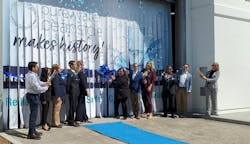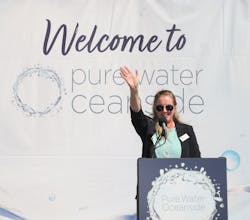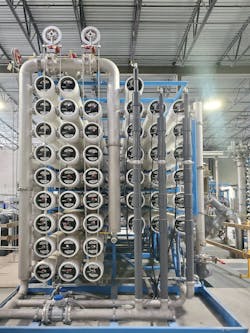Plant Profile: Pure Water Oceanside
As is the case with most southern California cities, the majority of Oceanside’s water travels from hundreds of miles away from the Colorado River and northern California’s Bay Delta.
The imported water is subject to rising costs, requires significant energy to transport and is vulnerable to natural disasters like drought and earthquakes.
Historically, a portion of the city’s water supply – which is delivered to 45,000 metered accounts – has come from the Mission Basin Aquifer. However, water stored within the aquifer is decreasing from long-term use and drought.
Scientists and engineers have worked in partnership with Oceanside city planners to identify a potential new drinking water source utilizing the groundwater basin.
The solution: the Pure Water Oceanside facility, which uses advanced technology to replicate nature’s water purification process to create a new source of drinking water. It is the first water reuse project to go online in San Diego County.
The $70 million project uses reclaimed water from the San Luis Rey Water Reclamation Facility, which treats the majority of Oceanside’s water to recycled water standards and supplies the Pure Water Oceanside facility through advanced technology – ultrafiltration, reverse osmosis (RO), and advanced oxidation – to replicate and accelerate the natural recycling process.
Starting this year, the project will provide more than 20% – or three to five million gallons per day – of Oceanside’s water supply in keeping with capacity designs.
Filtration with filters 300 times smaller than a human hair remove small particles from the reclaimed water. RO uses ultrafine filters 100,000 times smaller than a human hair to remove salts, chemicals, bacteria, viruses, microplastics and pharmaceuticals.
In the final polishing step, advanced oxidation uses UV light and chlorine to neutralize any remaining trace substances. It is the same technology used to sterilize surgical equipment and baby food jars.
The water at this point is so pure it is near distilled in quality and meets or exceeds drinking water standards. Minerals are added to the water and then injected into the Mission Basin Aquifer.
The water remains underground for several months – providing additional treatment – and then is extracted from the aquifer and treated again at the city’s Mission Basin Groundwater Purification Facility.
The project is designed to provide new local high-quality drinking water that is clean, safe, drought-proof, environmentally sound and cost effective. Pure Water Oceanside will recharge the local groundwater basin, minimize seawater intrusion, and improve the basin’s water quality.
Recently dedicated in a public ceremony, guests took guided tours of the Pure Water Oceanside and San Luis Rey Water Reclamation facilities. It also is receiving overwhelmingly positive approval by local residents, according to Lindsay Leahy, P.E., City of Oceanside principal water engineer.
The foundation of the project was a goal set by the Oceanside City Council directing the city’s Water Utilities Department to develop a 50% local supply by 2030 to move toward water independence, notes Leahy.
The city then studied potable water reuse and desalination feasibility.
“While both were options, we moved forward with Pure Water Oceanside, the indirect potable reuse project, because it was more cost-effective for our customers,” Leahy said. “Desalination is still an option for us in the future if we choose to go that route as well and expand beyond 50% local supply. but it was just not as cost-effective.”
Another goal was to have a small footprint, says Leahy. Tetra Tech served as the design firm. Some products were sourced locally, such as Hydranautic’s membranes for the plant’s ultrafiltration and RO. Trojan provided the UV and advanced oxidation technology.
“They also have been working on an algorithm that automatically adjusts the dosage of UV light based on water quality,” Leahy said. “It lowers the electrical demands on the technology so we’re not dosing more UV than we need. It automatically modulates that.”
The project has two phases. The current phase takes Oceanside from using 89% imported water, 10% groundwater/RO and 1% recycled water for irrigation to using 67% of imported water, 21% of Pure Water Oceanside/Groundwater and 12% recycled water for irrigation.
The groundwork is being laid for the second phase, after which Oceanside will use 44% imported water, 32% Pure Water Oceanside/Groundwater and 24% recycled water for irrigation.
“We’re working with the state and the regulatory agencies to do some additional studies and then we’ll plan on requesting to increase the amount we can inject because we do have that capacity available to us,” Leahy added.
The launching of Pure Water Oceanside coincides with a larger movement to create sustainable water supplies in San Diego County. Two other water reuse projects are planned for the region: the East County Advanced Water Purification Program and Pure Water San Diego.


